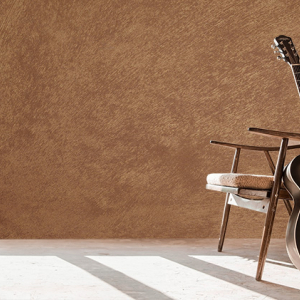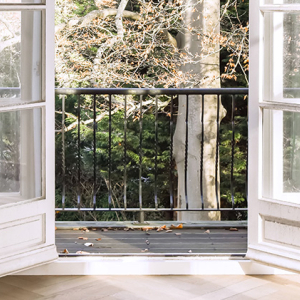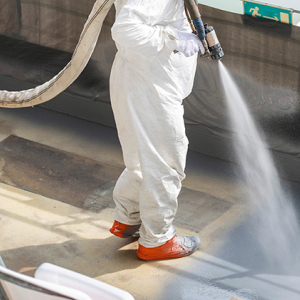
Protection of wooden façades and outdoor furniture with oil
Due to its natural warmth, aesthetic appearance and durability, wood is a popular material for exterior façades. However, as it is outside, it is exposed to the effects of weather – UV rays, humidity, cold, heat and biological pests such as fungi and mould. An effective and environmentally friendly method of protecting wooden surfaces is to use a suitable wood oil for exterior vertical surfaces (fences, façade, furniture, etc.), such as Belinka Oil House&Garden.
Why choose oil for protection of outside wood?
Oiling the wood highlights its natural structure, brightens and colours it. The oil penetrates into the pores of the wood, fills them and prevents the absorption of other liquids, while forming an extremely thin protective film on the surface. The oiled surface repels water and dirt, but is not waterproof. Oiling does not seal wood, the surface is vapour permeable which enables wood to “breathe”, meaning that its natural humidity is adjusted according to the surrounding environment, which gives the treated surface a natural feel. Oiling wood does not create a hard protective layer on the surface, so there is no risk of peeling and blistering due to shrinkage and swelling of the wood, which makes maintenance and restoration much easier.
APPLICATION AND MAINTENANCE PROCESS
Preparation of wooden surfaces
For exterior surfaces, we recommend using hardier woods such as acacia, oak, red cedar, chestnut, larch and tropical woods such as teak and bangkirai. These contain extractive substances that protect the wood from biological pests. The wood must be completely dry, sanded well and evenly and dusted, free of grease, wax and other impurities. The recommended moisture content of the wood is 12–15 %. For wood containing naturally occurring oils and high levels of water-soluble substances such as tannin (oak, chestnut), we recommend exposing the wood to the effects of the weather (rain, sun) for at least one month before the first coating. This removes the tannin and naturally occurring oils from the surface.
Application
Apply the oil in a temperature range of between 15°C and 25°C and at a relative air humidity of 40–70%. The optimal working temperature is between 18 °C and 22 °C. At lower temperatures and/or higher relative humidity, the drying time may be prolonged. The drying time is also increased with thicker applications of the coating. We advise against coating with this product if the temperature is below 15°C and in humid weather. In spring and autumn, when temperatures are lower and humidity is high in the morning and evening, wood surfaces should be coated in the middle of the day when temperatures are higher and humidity and moisture content in the wood are lower.
Mix the product well before use and apply undiluted with a brush or roller. Make sure to spread it well and evenly with brush or roller strokes, so that the prescribed amount is applied per m2 of the surface area (15-20m2/1l). Apply the oil to all the wood’s surfaces, and pay particular attention to the transverse cuts. It is applied in two coats with an interval of 24 hours. The surfaces are completely dry after 7 days. Any damage to the wood caused during installation (e.g. screw holes) should be further protected, as the wood is not well protected in these areas.

Maintenance
The maintenance interval depends on the type of wood, the mechanical stresses and the exposure to moisture and sunlight. The condition of the protection of oiled and weather-exposed elements should therefore be checked regularly. The check should be carried out at least once a year. Weather-exposed wood expands and contracts due to the absorption and release of moisture. This results in cracks in the wood that need to be filled with oil to prevent water from entering into the cracks and deeper into the wood. We therefore recommend recoating as needed or when the surface is no longer water-repellent. The recoating process is the same as for the first coating.
Color shades
The product is available in the standard five colour tones of the COLOURS colour chart. Additional tinting is possible in more than 60 shades according to Belinka's colour chart. As wood is a natural material, there may be slight deviations in the shades of wood of different quality. On other types of wood, the shade may vary more, so we always recommend a test application on a smaller sample of wood beforehand. The colour shade on the wood also depends on the previous treatment of the wood and the number of coats.
Characteristics of Belinka Oil House&Garden
- for all vertical exterior wooden surfaces,
- ensures protection against moisture and UV rays,
- forms a thin film on the surface – less frequent maintenance compared to other oils,
- easy application and restoration,
- water repellent and slows the growth of mould,
- does not need to be wiped – intended for larger surfaces as well,
- application with brush or roller,
- does not peal or crack,
- contains biodegradable components.
TIPS AND WARNINGS
Wooden elements heavily exposed to moisture can be protected with a biocide agent prior to the first application of the oil.
Wood that has greyed naturally and you would like to restore its natural colour can be pre-treated with Belinka Belfresh.
Additional tinting of the oil provides extra UV protection.
The drying of vegetable oils is oxidation, which is an exothermic reaction that releases heat. Oiled cloths and sponges can therefore heat up excessively, which can lead to self-combustion.
Oil soaked cloths and other porous working accessories (foam rollers, sponges, paper) must be soaked in water or burnt immediately after use, otherwise spontaneous combustion may occur.
With its natural look and ease of use, Belinka Oil House&Garden is the ideal choice for those who want to not only protect their wooden façade, but also prolong its life and preserve its original beauty.




